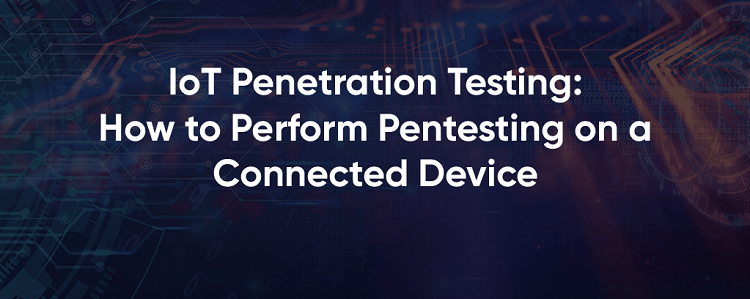The Internet of Things (IoT) is a vast, interconnected web of devices that communicate and exchange data via the internet. Any instrument that uses sensors to collect and transmit information can be an IoT device, which includes everything from smartphones and wearable technology to household appliances and industrial equipment. However, the connectivity of IoT devices also raises security concerns—and that’s where IoT penetration testing comes in.
According to a report by Palo Alto Networks, 98 percent of IoT device traffic is unencrypted, potentially exposing sensitive information to eavesdroppers. Moreover, the report finds that 57 percent of IoT devices are susceptible to medium- and high-severity exploits, making them an extremely appealing target for an attacker (Palo Alto Networks, 2020).
Despite the security risks, the number of IoT devices is soaring. Statista estimates that the number of devices connected to the Internet of Things will more than double between 2022 and 2030—from 13.1 billion to 29.4 billion (Statista, 2022).
Many IoT devices are used in homes, businesses, and critical infrastructure such as hospitals and power plants, and to help protect this massive array of devices, organizations need to perform IoT pen testing. This article will discuss the definition and purpose of IoT penetration testing, as well as how to perform pentesting on IoT devices.
What is IoT Pentesting?
Penetration testing (also called pentesting) evaluates the security of a computer system or network by simulating a cyberattack. Penetration testing aims to discover security vulnerabilities and flaws that can then be corrected or mitigated before malicious actors take advantage of them.
IoT penetration testing is the act of penetration testing for Internet of Things devices and networks. This involves the security of the IoT device itself and the communications it sends and receives (e.g., with other IoT devices and cloud computing platforms).
The techniques used in IoT pen testing include:
◉ Analyzing network traffic.
◉ Reverse-engineering the device’s firmware.
◉ Exploiting vulnerabilities in IoT web interfaces.
These methods enable IoT penetration testers to find security flaws such as weak passwords, unencrypted data, insecure firmware, and a lack of proper authentication or access control.
What is the Objective of an IoT Pen Tester?
IoT penetration testing is an essential component of a strong, comprehensive IT security program for an organization’s devices and networks. IoT pen testing aims to identify and address issues with an organization’s IoT security posture that could allow attackers to steal confidential data or gain unauthorized access to an IoT device or network. By fixing these vulnerabilities, IoT pen testers help improve the security and resilience of their systems and significantly reduce the chance of cyberattacks.
How to Approach IoT Security
IoT security is a complex and evolving field, with organizations constantly trying to stay one step ahead of their attackers. Besides IoT penetration testing, there are several ways that businesses can strengthen their IoT security:
◉ Authentication and access control: IoT devices should be protected by authentication methods such as strong passwords and multi-factor authentication. In addition, users should be granted only the permissions necessary for them.
◉ Encryption: Data transmitted between IoT devices or between the device and the cloud should be encrypted to protect against interception and tampering. If the device stores confidential or sensitive data, this information should also be encrypted at rest.
◉ Software updates: IoT device manufacturers often release updates to address security vulnerabilities and other issues. Businesses should have processes in place to regularly update IoT firmware and software.
◉ Logging and monitoring: Monitoring IoT devices for unusual activity and anomalies can help detect signs of compromise by a malicious actor. Organizations can use security analytics and threat intelligence tools to detect and respond to threats in real time.
Why is an IoT Audit Required?
IT security auditing is an important methodology for understanding and improving the effectiveness of an organization’s IT security posture. Within the broader field of IT security, businesses may have vulnerabilities in certain aspects, such as network security or application security.
With more organizations using more IoT devices, an IoT audit can help assess the security of these devices and networks. IoT audits may be required for reasons such as:
◉ Asset management: Organizations with many IoT devices can help keep track of these devices and assess their functionality with an audit.
◉ Performance management: Audits can evaluate the performance of IoT devices, ensuring that they are functioning properly and delivering the expected business value.
◉ Risk management: IoT audits can help identify unsecured devices and determine the risk of an IoT security incident.
◉ Compliance: Laws and regulations like the European Union’s GDPR and HIPAA for healthcare organizations may require companies to keep IoT data secure and private.
IoT Pentesting Methodology: How to Pentest an IoT Device
What does the IoT penetration testing process look like? The steps of IoT pen testing are as follows:
1. Planning and reconnaissance: First, penetration testers gather information about the target system or network. This may include the number and types of IoT devices, the network architecture, and any security controls in place.
2. Vulnerability scanning: Pen testers use vulnerability scanning tools to identify potential flaws in the IoT device or network, from misconfigurations to access control issues.
3. Exploitation: Once penetration testers have identified security issues, they attempt to fully exploit them possible, using them to enter and launch an attack on the network.
4. Post-exploitation: After gaining access via a particular security vulnerability, pen testers seek to extend their reach throughout the network, gathering more information or escalating their privilege. This may include installing malware or exfiltrating sensitive data.
5. Reporting and remediation: At the end of the process, IoT penetration testers produce a report detailing the vulnerabilities discovered, the extent of the attack, and the recommendations for solving or mitigating the issue.
Source: eccouncil.org





0 comments:
Post a Comment